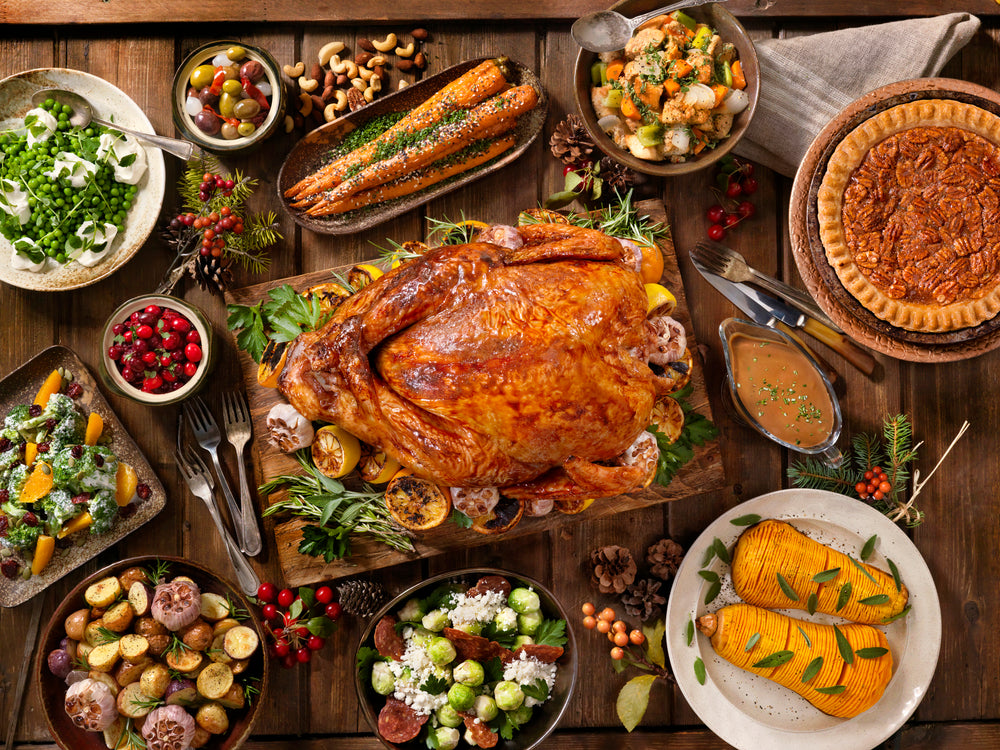Christmas spirit is contagious and palpable in Britain. The nation comes alive with the spirit of the season as soon as December arrives. On chilly winter evenings, streets are illuminated with sparkling lights and exquisitely decorated Christmas trees, casting a warm and inviting glow. The entire nation sparkles with holiday spirit. In Britain, the holiday spirit is contagious and palpable. As soon as December arrives, the whole country begins feeling festive. Beautifully decorated Christmas trees and sparkling lights cast a warm and inviting glow across the streets on chilly winter nights. Holiday cheer sparkles every corner of the country, and the streets are filled with the aroma of delicious delicacies that people begin for Christmas.
Some Famous Treats and Festive Feasts Prepared on Christmas
Roast Turkey
In Britain, a traditional Christmas dinner is often thought to revolve entirely around the turkey. Although the bird has been connected to holiday feasting since the late Tudor era, it wasn't until the 20th century that it came to be considered almost a requirement on December 25. The Christmas dinner menu varied greatly by class, even during the Victorian era, and the turkey was by no means the only meat served.
Traditionally, turkey is roasted till golden and seasoned with a flavourful mixture of herbs. It is a festive feast that is served with a variety of delicious sides. Each bite of the stuffing for the turkey is a flavourful combination of breadcrumbs, herbs, onions, and occasionally sausage. This dish is enhanced by a delicious gravy made from the pan drippings and the cranberry sauce, which gives it a touch of sweetness. It is served with crispy roast potatoes, sautéed Brussels sprouts, and other seasonal vegetables.
Christmas Plum Pudding
Traditionally, Christmas Pudding was prepared using 13 ingredients representing Jesus and his 12 disciples. Every family member stirred the pudding, turning the ladle from east to west. Modern-day Christmas puddings comprise breadcrumbs, dried fruits (especially raisins) soaked in alcohol, suet, treacle, etc. The pudding is then steamed for several hours, and a technique known as flambe is used to ignite the dessert in flames with the help of drizzled alcohol over it before it is served.
Shortbread

Shortbread is a traditional Christmas treat with a long history that dates back to medieval Scotland. It is a popular holiday treat because of its buttery, crumbly texture and slightly sweet flavour. Back in the days, shortbread was saved for special occasions like Christmas and Hogmanay. While shortbread is commonly available these days, it is still a cherished treat of holiday customs. They are baked into a variety of shapes, including ones with holiday themes, and dusted with sugar to give it a touch of sweetness.
Mince Pies
Back in the days, mince pies were considered a status symbol as initially only the wealthy could afford them. They would present pies in a variety of shapes, like crescents or hearts, to display their wealth.
However, they became popular after a medieval custom of eating mince pies for 12 days from Christmas to Twelfth Night became a popular practice. People believed that doing so would bring them happiness for the next 12 months. Small pastries are filled with mincemeat along with a combination of dried fruits, spices, sugar, and occasionally brandy or rum and baked till golden and crisp. It is a delightful holiday dessert most often served with some clotted cream, powdered sugar, or a scoop of vanilla ice cream.
Pigs in Blankets

This is a popular holiday appetizer that is a popular Christmas treat in the UK. These delightful morsels consist of cocktail or chipolata-sized sausages that are tightly wrapped in streaky bacon. People love them because they combine savory, juicy sausage and crispy bacon. They are served as tasty finger foods or as an addition to the main course at festive gatherings and Christmas dinners.
Christmas Trifle
The first recorded mention of a trifle-like dessert dates back to the reign of Elizabeth I when it was thought to be a way to use up leftover cake and fruit. By the 18th century, it had become a special dessert to be served which was served for dessert for Sunday lunches or family gatherings. Christmas trifle is basically a dessert made of custard, fresh berries, fruit preserves, and whipped cream between layers of sponge cake or ladyfingers that have been soaked in sherry or fruit juice. People also like to sprinkle chocolate shavings or slices of almonds over it before serving. It is an important part of the Christmas celebration and is intentionally served in glass bowls so its colourful layers are visible to all.
Yule Log
The Vikings are known to have celebrated a Winter Festival, which they called Yule. The Yule Log was actually a giant log that the Vikings would burn and sit around, telling stories to each other. The dessert is a rolled sponge cake filled with buttercream, whipped cream, or other creamy fillings—often with chocolate or coffee flavor. A layer of chocolate or coffee-flavoured buttercream is applied to the exterior of the log to resemble tree bark and sprinkled with powdered sugar to represent snow. Some versions of the Yule log also have extra decorations like meringue mushrooms, marzipan holly leaves, or tiny figurines matching the Christmas theme.
Gingerbread Cookies

Gingerbread has been a part of Christmas for many centuries. They were a staple in medieval fairs in England. There were festivals known as Gingerbread Fairs, and the gingerbread cookies served were referred to as fairings. These cookies are made from ginger, cinnamon, and molasses-flavoured dough that is rolled out and cut into different holiday shapes like stars, trees, and gingerbread men. They are often decorated with vibrant icing, candies, or sprinkles, making them a delightful treat and cherished holiday tradition ideal for gifting and decorating during the festive season.
There are many more festive treats and feasts that people love to make during Christmas such as chocolates, mulled wine, roast potatoes, Yorkshire puddings, tipples and more.


 Easter 2026
Easter 2026
 Frozen Food
Frozen Food
 Baking
Baking
 Beans, Peas, Soups & Tins
Beans, Peas, Soups & Tins
 Biscuits, Crackers & Cookies
Biscuits, Crackers & Cookies
 Candy / Sweets
Candy / Sweets
 Crisps & Snacks
Crisps & Snacks
 Chemist / Pharmacy
Chemist / Pharmacy
 Desserts
Desserts
 Gravy, Stock & Paste
Gravy, Stock & Paste
 Haggis
Haggis
 Indian Sauces, Paste and Pickle
Indian Sauces, Paste and Pickle
 Jams & Preserves
Jams & Preserves
 Poppy Appeal
Poppy Appeal
 Pot Noodles & Super Noodles
Pot Noodles & Super Noodles
 Scone Mix
Scone Mix
 Gluten-Free / Free From
Gluten-Free / Free From
 Tea Accessories
Tea Accessories
 Teapot & Tea sets
Teapot & Tea sets
 Tea For One
Tea For One
 Sugar & Creamer
Sugar & Creamer
 Tableware
Tableware
 Serveware
Serveware
 Plates & Trays
Plates & Trays
 Bowls
Bowls
 Cups & Saucers
Cups & Saucers
 Mugs
Mugs
 Silverware
Silverware
 Dinnerware - Accessories
Dinnerware - Accessories
 Dinnerware - For Pets
Dinnerware - For Pets
 Victoria Eggs - Hand-Drawn UK Homeware
Victoria Eggs - Hand-Drawn UK Homeware
 Jewelry & Accessories
Jewelry & Accessories
 Sale
Sale
 Christmas Gifts
Christmas Gifts

